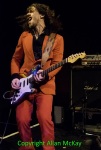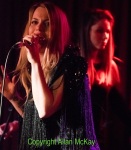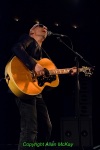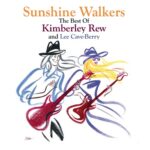 I have a huge admiration for great songwriters; crafting songs that perfectly convey little slices of life or eternal truths without knowing whether the song will reach half a dozen or millions of people or whether it will hibernate for years and emerge as a shiny (and profitable) hit. Nick Lowe was virtually potless after having a string of hits in the late seventies/early eighties when “(What’s So Funny ‘Bout) Peace, Love and Understanding?” appeared on the soundtrack of “The Bodyguard” as a Curtis Stigers cover in 1992. Kimberley Rew’s career took a slightly different trajectory; as a member of Katrina and the Waves, after several years grinding around Air Force bases and Canadian Clubs, he wrote the massive hit “Walking on Sunshine” and Eurovision winner “Love Shine a Light”, and The Bangles had a minor hit with a cover of his song “Going Down to Liverpool”.
I have a huge admiration for great songwriters; crafting songs that perfectly convey little slices of life or eternal truths without knowing whether the song will reach half a dozen or millions of people or whether it will hibernate for years and emerge as a shiny (and profitable) hit. Nick Lowe was virtually potless after having a string of hits in the late seventies/early eighties when “(What’s So Funny ‘Bout) Peace, Love and Understanding?” appeared on the soundtrack of “The Bodyguard” as a Curtis Stigers cover in 1992. Kimberley Rew’s career took a slightly different trajectory; as a member of Katrina and the Waves, after several years grinding around Air Force bases and Canadian Clubs, he wrote the massive hit “Walking on Sunshine” and Eurovision winner “Love Shine a Light”, and The Bangles had a minor hit with a cover of his song “Going Down to Liverpool”.
After Katrina’s departure in 1999, Kimberley carried on writing and recording with his partner and bass player Lee Cave-Berry. The songs were still superb, but weren’t troubling the charts; this is the period covered by the twenty-one (count them, twenty-one) songs on “Sunshine Walkers”.
Kimberley Rew is a very English lyricist, in the same vein as Ray Davies, Nick Lowe, Chris Difford and Billy Bragg; the songs couldn’t come from another country; there’s a self-deprecation and irony that you don’t find anywhere else. The other thing he has in common with these writers is that they can all conjure great songs out of the most prosaic situations: Chris Difford wrote the lyrics for the Squeeze classic, “Tempted”, on a journey to Heathrow.
And so it goes, on the album’s first song, “The Dog Song”, inspired by seeing dogs on an obstacle course for TV entertainment, is a romp through Chuck Berry territory with humorous lyrics, clever rhymes and perfect harmonies. It gets the album off to a flying start and sets the tone for a bunch of songs covering various musical styles and even a couple of those songwriters’ favourites for occasions that recur annually, “All I Want is You for Christmas” and “Happy Anniversary”.
Of the remaining dozen and a half songs, there’s absolutely no filler and several that push all of my buttons, mainly the quintessentially English ones. “Bloody Old England” is Billy Bragg meets Victor Meldrew homesickness for this grey old country set to a skiffle beat, while the national pride and clever rhymes of “English Road” wouldn’t have sounded out of place on an eighties Rockpile album. And let’s not forget “Backing Singer Blues”; I’m not a great fan of the humorous song, but this one actually works. It slightly exaggerates a situation everyone in the business can identify with, and it’s catchy as all hell.
It’s not often that an album can grab my butterfly attention span for twenty-one songs, but “Sunshine Walkers” did it; Kimberley Rew is one of our national treasures whose talents deserve much more exposure.
“Sunshine Walkers” is out now on KL Recording (KL013).
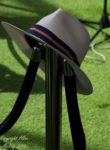 This started the way the best features do, as a conversation in the pub. We’ll let Allan take it from there.
This started the way the best features do, as a conversation in the pub. We’ll let Allan take it from there.
It’s one of the oldest tricks in the pop music book; if the song’s on its last legs and you still need another thirty seconds or so to get you up to the optimal time for radio play, then you deploy one the producer’s most potent tactical weapons – the trucker’s gear change. In its most basic form, the whole arrangement shifts up a tone or a semitone, to grab back your attention before the chorus repeats and fades. Usually, it just happens once, but that depends on how desperate you are (or how weak the song is). You might even get some clever stuff going on to get from one key to the next; when that happens, you get all classical and call it a modulation. What do they sound like? Let’s start with an absolute clunker.
“I Will Always Love You” – Whitney Houston
Considering the quality of the musicians available to producer David Foster, this TGC is bone-jarringly unsubtle; there’s no attempt to pretty it up by repeating a riff in the new key or moving through a few passing chords. Oh no; old key/bang/new key – we’re done. As if that’s not enough, there’s a whole bar of almost complete silence before the melody crashes back in again, maybe David Foster thought that the average listener couldn’t remember which key the song was in after 4 beats. Who knows; anyway it’s a crash/bang/wallop of the highest order and you can hear the teeth grinding off the flywheel:
“Love on Top” – Beyonce
OK, we’re now well and truly in the era of digital recording and production and it’s much easier and quicker to manipulate sounds. You can do a TGC with a mouse-click. If it’s so easy to do, why not do loads of them – one is good, two must be better. Beyonce co-produced this with Shea Taylor, so she’s sharing the blame here. In the last ninety seconds of the radio edit there are four, yes four upward key shifts as the chorus is repeated. It makes you wonder what it would be like if the key shift just kept repeating. As it happens, someone thought of that. Here it is with fourteen upward shifts:
“The Snake” – Al Wilson
Ah, the old Northern Soul classic. Fans will remember that one of the UK pressings of this song had a cover of the John Fogerty classic “Lodi” on the b-side. That’s not relevant, just me showing off. Sometimes you can get away with a few stick shifts if you’re building up to the climax of the song and that’s what happens here. At the end of the second verse, there’s a bass riff which is then repeated a tone higher and you’re in a different key. It’s not just a chorus repeated in exactly the same way but higher, it’s part of the process of moving the story along. And the same device is repeated at the end of the third chorus into the final verse as the song reaches its dramatic finale. Maybe I’m biased, but I think this is part of the arrangement of the song and that keeps it out of Room 101:
“Heat Treatment” – Graham Parker & the Rumour
You might think that any key change part way through a song would be agreed with the writer; it ain’t necessarily so. This was the title song of GP and the Rumour’s second album “Heat Treatment”, released in 1976, the same year as his debut “Howlin’ Wind” (two albums in a year and incessant gigs; musicians grafted in those days). Partway through the song, there’s a modulation; it’s quite musical – a two-bar horn section phrase takes the song up a tone. It’s not lumpy but it does the job fairly quickly. The problem is that it’s not part of generating extra excitement, just the opposite. It takes the song into a bass riff breakdown and the groove has to be built up again from scratch. Graham Parker made his feelings about it known when the album was remastered for CD; his sleeve notes refer to it as ‘that abusive key change’. Fair enough.
“Up the Junction” – Squeeze
This was the title track from the second Squeeze album, with a tip of the hat to Nell Dunn who wrote the novella of the same name. Glenn Tilbrook and Chris Difford were just beginning to realise their potential as songwriters and Jools Holland was still their keyboard player. This is a key change that is about as far from a trucker’s gear change as you can get. It’s a modulation that reflects a downbeat turn in the lyrics through a ten-bar bridge using minor chords before dropping a whole tone for a more upbeat verse and then, paradoxically, going back up by a whole tone for the downbeat final verse. Difford and Tilbrook characteristically messing with the conventions. Bits of “Up the Junction” trivia? There are no choruses and the title of the song doesn’t appear in the lyric until the last three words:
Allan was a bit chuffed to get his first big festival photo accreditation this summer for Cornbury Festival in Oxfordshire. It was perfectly timed to coincide with a complete weekend shutdown of rail services through Oxford during the hottest weekend but it takes a lot more than that to stop a determined photographer. When he eventually made it there, well, we’ll let him tell you about it.
OK, Friday night and the first band to play in the dark with stage lights was Stereo MCs. Had to be done really. It was a bit of a nostalgia thing; loads of memories of my DJ days in the late eighties/early nineties. From the outset, it was obvious that Rob Birch is still a hugely charismatic and dynamic frontman. I think this just about captures it:
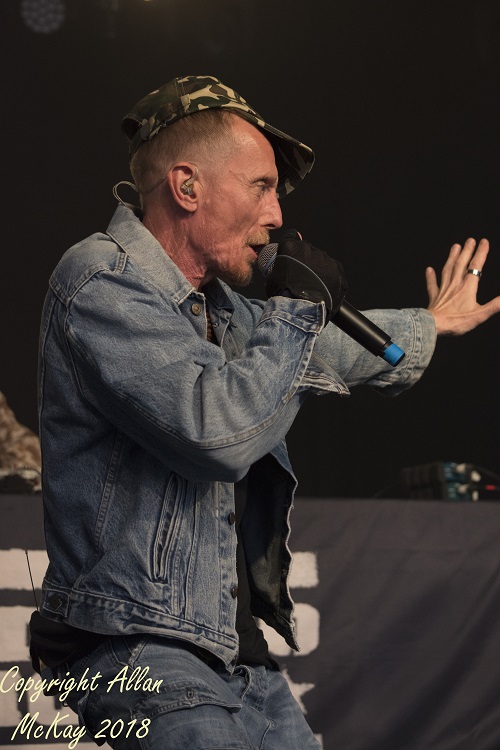
Last set on Friday night was UB40. I saw UB40 on their first national tour when they supported The Pretenders on tour across the UK in 1980. They were fired up, they wanted to succeed and they sounded amazing. Nearly forty years on, it’s a very different story; there are two UB40s touring and neither’s convincing. This version is pretty pedestrian, but they have one secret weapon – Brian Travers. I’m sure he wouldn’t claim to be the best sax player in the world, but he knows how to sell it:
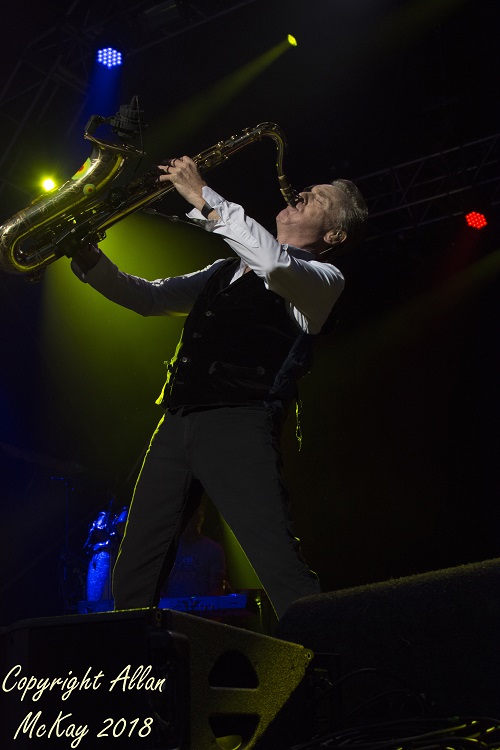
Saturday night was busy (although Alanis Morissette decided not to allow any press access for her set) and the Songbird Stage was the place to be. Obviously Mavis Staples was a do-not-miss, but PP Arnold was another. You would think she’d never been away; she sounded fabulous and looked like this:
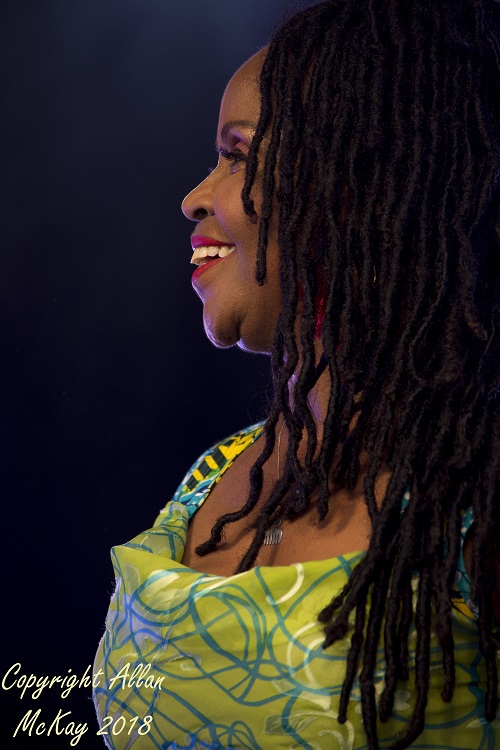
Sunday afternoon on the Pleasant Valley Stage; anyone for a bit of Deacon Blue? Definitely; I saw them a couple of times in the very early days and I loved them. It’s partly a Scottish thing, but it’s mainly a music thing. They have great songs and they have the experience to sell them on a festival stage. You never know, Ricky might do a bit of politics. Actually you do know, he will. Anyway, he’s looking pretty pumped these days:
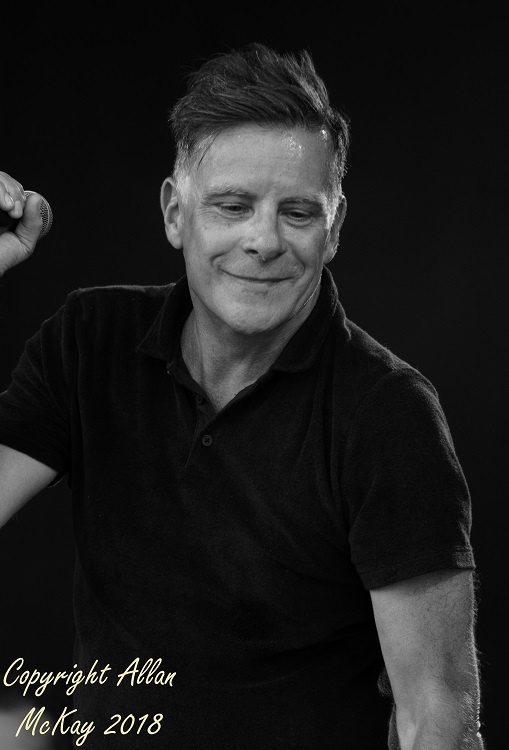
Sunday evening headliners – Squeeze. We go back a long way; I saw Squeeze for the first time at Dundee University Students’ Association; there were more people on stage than in the audience and it was still a great gig. I’ve photographed them on occasions forty years apart (I know, I don’t look that old) and I still love those Difford/Tilbrook songs. This time, it was Yolanda Charles that really caught my eye:
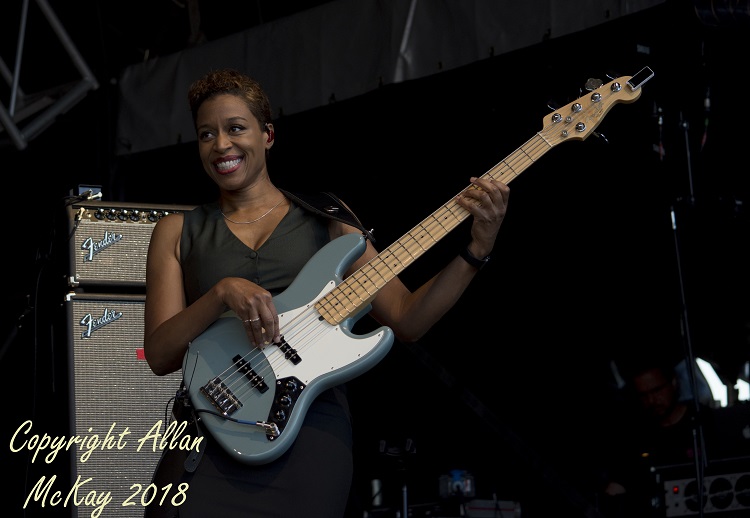
If you want to treat yourself or someone close to you to who’s a music fan to something interesting for Christmas, then we’ve got a few ideas for you. There are books, an album and a very interesting merchandising idea.
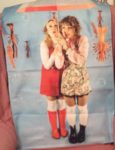 Sound of the Sirens merchandising – I love Sound of the Sirens. Abbe Martin and Hannah Wood are incredibly talented writers and performers, but there’s a lot more to it than that. They attract like-minded people into their orbit and create friendships between fans from all over the country. They also have some interesting ideas about merchandising. Selling mugs is fairly standard, but why not take it a stage further and sell tea towels with a picture of the band. And what a great strapline: “Wipe your mugs with our mugs”.
Sound of the Sirens merchandising – I love Sound of the Sirens. Abbe Martin and Hannah Wood are incredibly talented writers and performers, but there’s a lot more to it than that. They attract like-minded people into their orbit and create friendships between fans from all over the country. They also have some interesting ideas about merchandising. Selling mugs is fairly standard, but why not take it a stage further and sell tea towels with a picture of the band. And what a great strapline: “Wipe your mugs with our mugs”.
 “Don’t You Leave Me Here: My Life” (book) – Wilko Johnson – Wilko has put together a memoir/autobiography that covers more than forty years in the music business, success, failure, cancer diagnosis and recovery, and coming to terms with his status as a legend. It’s a great fly-on-the-wall insight into the workings of bands and the music business and it’s well worth reading. I had a bit of a shock when I realised that the Solid Senders bass player who I had photographed in 1977 in Dundee was the same person I photographed playing bass in Phil Burdett’s band in Southend last year. Small world.
“Don’t You Leave Me Here: My Life” (book) – Wilko Johnson – Wilko has put together a memoir/autobiography that covers more than forty years in the music business, success, failure, cancer diagnosis and recovery, and coming to terms with his status as a legend. It’s a great fly-on-the-wall insight into the workings of bands and the music business and it’s well worth reading. I had a bit of a shock when I realised that the Solid Senders bass player who I had photographed in 1977 in Dundee was the same person I photographed playing bass in Phil Burdett’s band in Southend last year. Small world.
 “I Knew You When” (album) – Bob Seger – Another one of my teenage heroes who’s still around and still relevant. This album came out of the blue; his 2014 album “Ride Out” had the feel of an album that was closing out a career and it might have been his swansong but for a tragic event. His old friend from Detroit, Glenn Frey, died earlier this year and this album is largely inspired by their friendship. Sometimes it’s right in your face (the album cover, for example) and sometimes it’s a bit more subtle – the title track is classic mid-tempo Seger with no names mentioned, but it’s obviously about Glenn Frey. It’s sad that it took such a tragic event to kickstart the album, but wonderful to hear a hero still so fired up about social issues.
“I Knew You When” (album) – Bob Seger – Another one of my teenage heroes who’s still around and still relevant. This album came out of the blue; his 2014 album “Ride Out” had the feel of an album that was closing out a career and it might have been his swansong but for a tragic event. His old friend from Detroit, Glenn Frey, died earlier this year and this album is largely inspired by their friendship. Sometimes it’s right in your face (the album cover, for example) and sometimes it’s a bit more subtle – the title track is classic mid-tempo Seger with no names mentioned, but it’s obviously about Glenn Frey. It’s sad that it took such a tragic event to kickstart the album, but wonderful to hear a hero still so fired up about social issues.
 “Going on the Turn” (book) – Danny Baker – It’s the third volume of Danny Baker’s memoirs, covering events to the present day, including his battle with head and neck cancer and high profile local radio sacking. He’s a natural writer who always manages to find a unique twist on even the most difficult subjects. It’s a life-affirming book and it’s all based in the area I’m working in at the moment, which gives it a nice personal touch. It’s a great read.
“Going on the Turn” (book) – Danny Baker – It’s the third volume of Danny Baker’s memoirs, covering events to the present day, including his battle with head and neck cancer and high profile local radio sacking. He’s a natural writer who always manages to find a unique twist on even the most difficult subjects. It’s a life-affirming book and it’s all based in the area I’m working in at the moment, which gives it a nice personal touch. It’s a great read.
 “Some Fantastic Place” (book) – Chris Difford – There’s a link to the previous book; Danny Baker went to the same school as Chris and their careers have touched at many points. I’ve always been a massive fan of Squeeze and this is a fascinating insight into the fraught relationship between Chris and Glenn Tilbrook. He doesn’t try to pretend that he’s perfect (far from it) and the book’s all the better for that. The only criticism (if you’re a geek like me) is that it would have benefited from some more rigorous fact-checking. It’s still a fascinating read.
“Some Fantastic Place” (book) – Chris Difford – There’s a link to the previous book; Danny Baker went to the same school as Chris and their careers have touched at many points. I’ve always been a massive fan of Squeeze and this is a fascinating insight into the fraught relationship between Chris and Glenn Tilbrook. He doesn’t try to pretend that he’s perfect (far from it) and the book’s all the better for that. The only criticism (if you’re a geek like me) is that it would have benefited from some more rigorous fact-checking. It’s still a fascinating read.
So how about five great gigs this year? Well, I’ve had plenty to choose from and I can’t say that I’ve seen a bad one, so it hasn’t been an easy choice to whittle it down to the top five (and no cheating this time either). These are all gigs that I walked away from feeling elated, feeling that I’d seen something special that I wanted to tell the world about. So I did, and here’s a reminder of how good these gigs were.
On a freezing February Friday night in Shoreditch, Rich Mix was a welcome respite from bars full of bankers and ‘exclusive’ lap-dancing joints. The venue is a social enterprise where the motivation isn’t purely profit and programming of events is always interesting. On this particular night, John Fairhurst, along with Pete Episcopo (bass) and Toby Murray (drums) played a raw and raucous set of blues focussing on the 2014 album “Saltwater”. Some of the album versions of the songs were fairly big production numbers but the live performance was strictly a power trio affair with John’s blistering guitar topping off the mixture. The journey back through Shoreditch didn’t seem quite so bad after a night of proper blues with electric guitars playing way up loud. You can see some photos from the gig here.
Mollie Marriott @The Half Moon
This one was firmly in the eagerly-anticipated category. Mollie’s been working quietly for some time putting together a great band for live and studio work featuring her Jim Stapley bandmates Izzy Chase-Phillmore, Sam Tanner and Johnson-Jay Medwik-Daley. After an interesting acoustic support set from her nephew, Mo Evans, Mollie’s full band made their first live appearance in a Half Moon packed with fans and a few well-known faces as well. It was obvious from the start that this isn’t just a bunch of hired hands; this is a bunch of really good mates as well. None of their playing is showy or attention-seeking; everything serves the songs and underpins Mollie’s phenomenal voice, and it all works perfectly. The audience were onside anyway, but Mollie and the band gave a great performance of material from the upcoming debut album and a couple of covers as well. Here are some photos of this one.
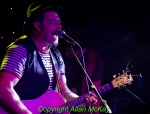 Mad Dog Mcrea and Sound of the Sirens @The Half Moon
Mad Dog Mcrea and Sound of the Sirens @The Half Moon
This was a very special gig. I’d been invited along to see Mad Dog Mcrea and I had no idea about the support on the night, Sound of the Sirens. It’s such a great feeling when you see an artist for the first time and you know instantly that they’re something special. And it’s not just me; apparently Chris Evans was quite impressed with them as well. Anyway, they played a storming set completely winning over the audience with their powerful songs, dynamics, and harmonies. If the night had stopped at that point, I would have been perfectly happy, but we still had Mad Dog Mcrea to come, with an energetic run through material from their album “Almost Home” plus a few old favourites and crowd pleasers. Two great bands with enough in common to appeal to the whole audience but with enough differences to create a very varied night. And there are some photos here.
 Squeeze and Dr John Cooper Clarke @Indigo2
Squeeze and Dr John Cooper Clarke @Indigo2
Another interesting double bill, this time with two very different artists, linked by the era which saw the start of their careers. John Cooper Clarke (now making the most of his honorary doctorate) has been doing poetry and comedy events for a few years but the tour with Squeeze put him back in front of big audiences filled with people who remembered him from the first time round. He throws more one-liners and gags into his routine now but a lot of the old favourite poems are still there, although some of them, particularly “Twat”, have evolved over time. On this night he was a barnstorming crowd-pleaser, building up the audience nicely for the headline act.
This year Squeeze had a new album to promote so the setlist was varied, to say the least, with material covering almost forty years from “Take Me I’m Yours” to new songs like “Cradle to the grave” with the usual smattering of different interpretations of Squeeze classics. What made this performance so special was the group of musicians (mainly Glenn Tilbrook’s Fluffers) now making up the rest of Squeeze who add upright bass, melodica and other esoteric instruments to the mix as well as adding rich vocal harmonies. Chris Difford and Glenn Tilbrook have never sounded better and what an incredible set of songs. Guess what, some photos here.
Graham Parker and Brinsley Schwarz & The Union Chapel
And finally. One of the greatest talents never to break through in the seventies and eighties, Graham Parker, who toured twice this year; once with The Rumour and once with Brinsley Schwarz. With a songbook which again covers almost forty years and a new album to promote as well, Graham Parker mixed up some established classics, some surprises and some new songs to delight an audience which might have been a little biased anyway. His voice is still remarkable and the songs are all strong enough to work in stripped-back arrangements. This wasn’t just a nostalgia thing; there were new songs to promote and they all sounded as good as anything he’s done before. He’s a remarkable man and it was a real pleasure to hear these songs in such a beautiful venue. How about a look at GP in the seventies and now?
 There’s only one band I’ve seen more often than I’ve seen Squeeze (answers in the comments box if you think you know who that is) and one of the interesting things they have in common is that they don’t have a precious attitude about the recorded versions of their songs. Chris Difford and Glenn Tilbrook have always been willing to try new arrangements; I must have heard half a dozen different versions of “Goodbye Girl” over the years and I never heard one I didn’t like. On this tour, Squeeze is basically Glenn’s band The Fluffers plus Melvin Duffy and they all play on the new album “Cradle to the Grave”; each member brings their own particular contribution to the overall sound. Simon Hanson is the archetypal drummer, full of energy and charisma, while his rhythm section partner, Lucy Shaw, dominates the right side of the stage with electric bass, double bass, ukulele and backing vocals. Stephen Large adds keyboards (including accordion and melodica) and Melvin Duffy plays just about anything with strings, including pedal steel and Weissenborn guitar. They’re all wonderful players (and singers) and add layer upon layer of instruments and vocals to the live sound.
There’s only one band I’ve seen more often than I’ve seen Squeeze (answers in the comments box if you think you know who that is) and one of the interesting things they have in common is that they don’t have a precious attitude about the recorded versions of their songs. Chris Difford and Glenn Tilbrook have always been willing to try new arrangements; I must have heard half a dozen different versions of “Goodbye Girl” over the years and I never heard one I didn’t like. On this tour, Squeeze is basically Glenn’s band The Fluffers plus Melvin Duffy and they all play on the new album “Cradle to the Grave”; each member brings their own particular contribution to the overall sound. Simon Hanson is the archetypal drummer, full of energy and charisma, while his rhythm section partner, Lucy Shaw, dominates the right side of the stage with electric bass, double bass, ukulele and backing vocals. Stephen Large adds keyboards (including accordion and melodica) and Melvin Duffy plays just about anything with strings, including pedal steel and Weissenborn guitar. They’re all wonderful players (and singers) and add layer upon layer of instruments and vocals to the live sound.
But what about Dr John Cooper Clarke as support? Well, he’s promoting his new album “Anthologia” and the idea of supporting a band’s nothing new; he did it hundreds of times during the punk era. Nearly forty years on, it still works; there are no musical rivalries between bands to worry about and JCC’s mix of manic recital and laconic links and gags is a perfect way to warm up for the Squeeze hometown gig. The old favourites are there, “Beasley Street”, “Evidently Chickentown” and “Twat” (including verses which weren’t in the original) as well as newer material like “Beasley Boulevard” dealing with the gentrification of inner cities. There’s more chat between poems than in the past and it’s usually hilarious, offering a novel and skewed perspective on everyday life. There’s the occasional stumble in the motormouth delivery, but that’s forgivable and he leaves the audience well and truly ready for the main event.
After an intro from Danny Baker, the set begins with Glenn Tilbrook wandering on stage while playing some intro music which morphs into “Hourglass”, with one of the catchiest of many catchy Squeeze hooks. As you might expect from two people with the experience of Glenn Tilbrook and Chris Difford, the set is perfectly paced, seamlessly weaving three-quarters of the new album in with the old classics and a few surprises. There’s a double hit of nostalgia on this tour as well, because the “Cradle to the Grave” material is set in the early seventies and a few of the songs are already familiar to the audience.
The quality of the band and the range of instruments they play allows for an incredibly varied set musically and visually; everyone sings and they’re able to vary the dynamics of the set by having the entire band along the front of the stage (and even into the audience) a couple of times for a more intimate acoustic feel. The performances are all absolutely spot on but there’s a hugely contagious enthusiasm at play as well. Everyone on stage is having a great time, and who wouldn’t, working your way through some of the finest pop songs ever written. There’s even a couple of non-originals too; The Tom T Hall classic “Harper Valley PTA” gets an energetic run through while Chris takes a lead vocal on a laconic version of Tom Waits’ “I Don’t Wanna Grow Up”. As for the hits, “Hourglass”, “Is That Love?”, “Another Nail in my Heart”, “Tempted”, “Pulling Mussels from the Shell” and “Up the Junction” are all fairly close to the originals while an intimate hits section in the middle of the set has a zydeco version of “Slap and Tickle”, an acoustic version of “Goodbye Girl” with congas, and stripped back acoustic version of “Black Coffee In Bed”.
Hearing those catchy, inventive melodies and clever but under-stated lyrics again is a reminder of the importance of this band to a whole generation in the UK, evoking a time when life wasn’t necessarily better but it was a lot simpler and the soundtrack was superb. You still have five chances to see them on the UK leg of their tour and “Cradle to the Grave” is available now as well. This might just be the time to re-acquaint yourself with two of British pop’s finest writers.
And here’s a coincidence; the only band that I’ve seen more times than Squeeze has two members who are big fans of Chris and Glenn. Who could they be?
Last Friday I had the opportunity to spend some time with the legendary Southside Johnny before the final show of his UK tour, featuring Gary “US” Bonds, at Shepherds Bush Empire. He was entertaining and engaging (as always):
AM – We did an interview here three and a half years ago and at that time you spoke to me about this acoustic thing that you might or might not be doing, which was really big news at the time and that’s happened now, so how’s that going?
SJ – It’s really good, it’s a fun thing. It’s really stripped down; we travel in a van together, we have breakfast in the morning as a band (there’s only six of us, with the road manager) and we set up our own equipment and tear it down and it really feels like the old days when you used to have to do that. It was a complete commitment to the whole day of travel, set up, play, tear down and travel again and even though I’m kinda long in the tooth I really enjoy it because it seems so organic and basic; there’s no star turns at all. I love playing acoustic music and it gives us a chance to play George Jones and Emmylou Harris and Bob Dylan and Tom Waits and some Bruce in a different format.
AM – You mentioned a few country artists there; you’ve always been a country fan haven’t you?
SJ – Yes I liked country when I was very young. What I didn’t know is that my mother, way back in the thirties when the ukulele was the big thing, she bought a ukulele from Sears Roebuck and she would sit on the porch with her father (her mother had died young) and some neighbours, and they would sing country songs, so I guess it’s in my blood, it’s the Irish part of me.
AM – I’ve heard you play “He’ll Have to Go” (country classic made popular by Jim Reeves) at The Astoria, I think.
SJ – Well, Soozie Tyrell, who plays violin with Bruce, she has a country band in New York City, and I would go up and do lots of songs with her because they’re real singer’s songs, they’re story songs with great melodies so it’s fun to make that kind of music.
AM – The old Jukes revolving door seems to have slowed down a little…
SJ – Not too much. We’ve got a new saxophone player, John Isley; I think (drummer)Tom Seguso’s been over here.
AM – At the time of the last interview, Joey (Stann, tenor sax) and Ed (Manion, baritone sax) were still with you but they’re obviously off doing other things now. There seems to be lots of side projects going on as well now that the New York Horns have made a record.
SJ – These days it’s a lot easier to make a record for a little money and it’s also easier to manufacture; for a buck apiece you can make as many CDs as you want and there’s a profit margin once you’ve paid for the studio time and the musicians and all the rest of it. I’m lucky that Jon Bon Jovi lets me use his studio but, even if he didn’t, studio time’s not as expensive as it used to be, home recording’s easier and the internet makes it easy to get distribution to all your fans round the world. It’s a good time to be a musician because you can do all the little things you want to do without incurring great expense.
AM – Did the side projects always happen to a certain extent; do we just hear about them more because of social media?
SJ – We’ve always done those things; Bobby (Bandiera, guitar, now playing with Bon Jovi) and I went out for months, here and there, doing a lot of charity gigs and they put us on a plane, in business class, just him and me and a guitar and harmonicas. We went all over and played charity things and it was just a chance to play in hotels and every little place you could find and it was a lot of fun because it was no stress.
AM – I saw you at Sheffield City Hall in 1995, I think, just the two of you doing the stripped back thing and it was a great night.
SJ – Well, if you have confidence in what you’re doing and you have material you think you can accomplish with just a guitar and a harmonica it’s a chance to explore all that too. Years ago Bobby, Rusty Cloud, David Hayes and I played in Paris at the Chesterfield Club. We did a two-week stint there with very little publicity and we rode the Métro and that was a lot of fun too. We all stayed in the same hotel, this funky little place and it was two weeks in Paris. I’m lucky I’ve had the chance to do those things and just explore what making music means other than pedal-to-the-metal trying to earn a living. I can do just about anything I want now. I’m never going to be rich, I’ve known that from the very beginning so there’s not a great stress to be a big star and make a lot of money; I make a living and that’s all I want. I just want to be allowed to do whatever kind of music I want to make.
AM – I was going through some of my very old Jukes records today and it struck me that after Billy Rush left, you got much more involved in the songwriting process; there’s not a lot of your songs on the early albums.
SJ – I was a writer back then but I would write certain things with certain people but the bulk of the song would be theirs and I’d say “forget it, I don’t want to have anything to do with it”. I wrote with Billy but I don’t have the kind of ego that I need to see my name on the album, but now with Jeff and Bobby the songwriting is really a collaboration so I get to write a lot of lyrics that I find interesting like “Into the Harbour” and “Winter in Yellowknife” and stuff like that which is not the norm for romantic love songs.
AM – On “Pills and Ammo”, it struck me that your name’s on every track as a writer. Do you have a certain way of working; do you do the lyrics and Jeff does the music?
SJ – It’s pretty much that way except that if I come up with a musical idea we’ll explore it and he helps me with lyrics; it’s a real collaboration in other words. I’ll come with an idea, a whole lyric and I’ll say “I think it sounds like this” and he’ll find a way to make it sound like what I want, but then he’ll say “what about this…” and we really try to bounce ideas off each other.
AM – I know Jeff’s a big fan of Squeeze and Difford and Tilbrook wrote in that way as well.
SJ – I’m a big Squeeze fan too.
AM – About your audiences; you’ve retained a very loyal audience in the UK. In the US, are the audiences different?
SJ – Well, they speak English. There’s people who come and see us a million times and there’s people who come and see us for the first time and usually we can win people over. It’s the energy and a lot of the music is made to lift you up so it’s not some shoegazer and it’s not some egomaniac, it’s really just music. I think one of the things that keeps people coming back is that it’s never the same night after night and I don’t know where it’s going to go and tonight’s going to be like that too because we’ve got Gary Bonds and we know what we’re going to do but when we get on stage, that may change.
AM – I’ve been watching Billy Walton live for a while and I’ve noticed that his crowd seems to be getting younger. I’ve seen teenagers at his shows but I’ve also seen people in their twenties who know all of the songs. I just wondered if that was happening with The Jukes.
SJ – We do get a lot of younger people; we had a bunch last night in Holmfirth, but we have our loyal fans and they’re the ones that usually get the first tickets and they’re older, but they bring their kids and some of them bring their grand-kids but anybody who’s willing to give us a shot we’re willing to play for as long as they come and have a good time and just enjoy themselves.
AM – November used to be the traditional time for a Jukes tour but the last couple of years you’ve been over during the summer. I’m guessing that’s because of festivals.
SJ – Yes. This year especially, because we had the Cornbury Festival to start it and we’re ending with Bospop in Holland so we had two festivals and we put a bunch of gigs in between and those get to be the anchor gigs. Unfortunately there’s new taxes in England, Foreigner Entertainer Tax (FET) and Hood, who settles everything got hit with it the other night and they wanted £1,400 for FET. Nobody knew exactly what it was but it’s legitimate and all that does is it makes it harder for bands like me to come over here; you can only lose so much money. On the one hand I guess they need the tax money but if they really need that, they should get all those people who hide their money offshore and let us poor bands try to play a little music.
AM – And a lot of musicians are hiding money offshore.
SJ – Well I’m not hiding any money; my money comes and goes and I get to see it as it goes past and that’s about it.
AM – Going back to the festivals, what’s the biggest gig you’ve ever played?
SJ – Probably Knebworth with Led Zeppelin. We did two shows; we did the first one, flew home and did a show in Washington DC, flew back and did the second show at Knebworth and flew home again, if I remember rightly, so it was a lot of flights. And we played about forty minutes but it was fun, it was a unique experience and we met some good people over here.
AM – As far as I can remember, and I was a long way away from the stage, it seemed like you got a pretty good response that day.
SJ – It seemed like that; of course we didn’t the full power that the headline act got (we don’t do that, if somebody opens up for us they get full power, but I’m not ever worried about a band opening up for us, I hope they do well). But I thought Led Zeppelin was terrible; there was no bass in the mix in the audience.
AM – That’s all the serious stuff but I’ve got couple of other questions for you. You’ve now got a huge body of work to choose from when you play; is there anything you feel can’t be left out?
SJ – Well, there’s nothing that can’t be left out, but I’m not there to just indulge myself, I’m there to give people what they want too and you split the difference. I know they want to hear “I Don’t Want to Go Home” and “The Fever” and “Trapped Again” or “Talk to Me” or “This Time It’s for Real” or “Love on the Wrong Side of Town” or whatever and you try to include those but when you twenty-two, twenty-three songs, there’s plenty of room for you to do what you want too. There are times when I say “I’m sick of this song, I’m not doing it” and it lasts for few months then it’s back in.
AM – Here’s one from my sister, who’s a big fan. Is there a song that makes you cry?
SJ – There’s a lot I guess. I’ve got some that I’ve written but Alison Krauss does a song called “I Can Let Go Now” which I think was written by Michael McDonald and it just kills me because I relate it to my mother. I don’t think that’s what it’s really about but for me it is and I just can’t listen to that song. There’s a lot; there are things that really touch me. I wouldn’t be doing if I didn’t get emotionally involved. When I was young and heard certain songs, I either got happy or excited or even felt sexy or touched, and to be part of that tradition is an amazing thing, but I’ve never really lost the idea that if someone sings a great song and really means it then I can get lost in the emotion.
AM – I find it really difficult to listen to “Many Rivers to Cross” after the version Jeff did here in 2010.
SJ – He really puts his heart and soul into it.
AM – Finally, hoping for another scoop, have you get anything in the pipeline?
SJ – Well, Jeff and I have written most of the songs for the next Jukes album; when we get it finished, I don’t know. We’re hoping to get in the studio, perhaps this winter and get it out some time next year. I’d love to get it out by Christmas but that’s just not gonna happen, and I’ve written some songs for a new Poor Fools acoustic thing and I’ve got a couple of other projects in mind too. I could retire if I wanted to, but then what would I do? I’d sit around the house, get fat and drink myself to death, and I can do that on the road.
AM – Johnny, many thanks for making the time for the interview.
SJ – My pleasure, any time.
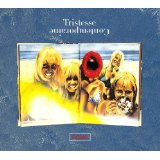 Tristesse Comtemporaine is a collaboration between former singer of Earthling, Maik, former Japanese punk singer, Marumi and Swedish guitarist Leo (a former hockey player) and “Stay Golden” is their second album. After hearing the album’s opening track a few months ago, I was interested enough to want to hear the rest of the album; intrigued, even. Perhaps I should have just left it at that.
Tristesse Comtemporaine is a collaboration between former singer of Earthling, Maik, former Japanese punk singer, Marumi and Swedish guitarist Leo (a former hockey player) and “Stay Golden” is their second album. After hearing the album’s opening track a few months ago, I was interested enough to want to hear the rest of the album; intrigued, even. Perhaps I should have just left it at that.
Once you get past the opening tracks, “Fire”, “Stay Golden” and “Waiting”, everything starts to sound very familiar. There’s a template which is applied to almost every track; the opening is minimalist percussion or synth sounds, a breathy vocal comes in and then layers are added as the song progresses. Where this works it works really well, but would you want to have the same food every time you eat?
Some of the elements are interesting; there are some nice synth sounds and the occasional blast of crunching guitar. The vocals are generally breathy and close-miked, sounding like something midway between Chris Difford (Squeeze) and The Beloved’s Jon Marsh, and they initially pull the listener in, like an orator lowering their voice for emphasis but the impact is lost when the technique is used constantly. There’s a lot of repetition on the album (drum patterns, looped synth lines and repeated lyrics) which gives the impression that Tristesse Contemporaine didn’t have enough original ideas for a whole album.
There are moments when the trio achieve what I think they set out to achieve and create moods that are languorous, menacing and disturbing both musically and lyrically. When this happens, it’s very powerful and evocative, but the problem for me is that it doesn’t happen often enough. The alienation evoked by the songs is emphasised in the videos but, ultimately, the project feels like an attempt to seem interesting by being self-consciously strange. It might work for you but it doesn’t really do it for me.
There some very interesting (and disturbing) ideas here musically and lyrically, but they are spread very thinly. Tristesse Contemporaine could have released a very good four or five track EP from this selection, but in this format, it’s a frustrating hint at what could have been a very good album.
Out now on Record Makers (REC 100-01-LC-16765).
 If there’s one thing that I really admire in musicians it’s the ability to survive; to come through the periods when you’re terminally unhip and still want to play, write and sing. It needs incredible self-belief and, sometimes, sheer bloody-mindedness (before we even talk about talent) to keep going in an increasingly tough business. If you’ve been writing, performing and recording for over 40 years and you’ve had a hand in songs as diverse as Ace’s “How Long”, Squeeze’s “Tempted” and Mike & The Mechanics’ “The Living Years” and The Eagles have covered one of your songs, then you deserve at least a fair hearing. So, Paul Carrack’s back again in 2012 and he’s sounding better than ever.
If there’s one thing that I really admire in musicians it’s the ability to survive; to come through the periods when you’re terminally unhip and still want to play, write and sing. It needs incredible self-belief and, sometimes, sheer bloody-mindedness (before we even talk about talent) to keep going in an increasingly tough business. If you’ve been writing, performing and recording for over 40 years and you’ve had a hand in songs as diverse as Ace’s “How Long”, Squeeze’s “Tempted” and Mike & The Mechanics’ “The Living Years” and The Eagles have covered one of your songs, then you deserve at least a fair hearing. So, Paul Carrack’s back again in 2012 and he’s sounding better than ever.
There are no bad, or even indifferent, tracks on “Good Feeling”; they’re all good and there’s stacks of variety in the in the styles and arrangements of the songs, but one thing makes this collection essential listening. Paul Carrack still has an astonishingly soulful voice; my good mate Steve J reckons he could sing the telephone directory and you would pay to listen and I don’t think he’s far off the mark. On top of that, he’s a great Hammond player and there aren’t many better instruments to accompany a great soul voice. The songs on this collection are a combination of Paul Carrack originals, collaborations with other writers and covers of songs by writers as diverse as Nick Lowe, Bruce Springsteen and Gerry Goffin and Carole King. It’s a great tribute to Carrack’s songwriting that his own songs are as strong as the covers although the best song on the album (my opinion here) isn’t one of his own, although it’s a great pick from a relatively unknown band.
The album opens with the Sam Cooke-tinged “Good Feelin’ About It” which, unsurprisingly, is a feelgood song and it’s followed by the Chris Difford collaboration “Marmalade Moon” bursting in with a horn section which wouldn’t sound out of place on a Southside Johnny album. The album flits effortlessly between musical styles, from the laid-back funk of “Nothing Without You” to the early Motown feel (including Stevie Wonder style harmonica) of “Time to Move On” to the pure 60s pop of the Goffin/King cover “When My Little Girl is Smiling”, which is very reminiscent of his 80s cover of the Jackie de Shannon classic “When You Walk in the Room”. The Nick Lowe and Bruce Springsteen covers (“From Now On” and “If I Should Fall Behind” respectively) both evoke the original performers while bearing the stamp of Paul Carrack’s incredible voice.
In my (almost) humble opinion, there are 2 songs which define the album and push it out of the Paul Carrack comfort zone. “Make It Right” is a cover of a lovely Tinlin brothers song with lots of minor chords and a slightly discordant riff, while “Long Ago” (a collaboration with Swedish songwriter Chris Antblad) could be a Brian Kennedy boy band single, but with grown-up lyrics. Any album of songs by Paul Carrack is going to be worth listening to, but these 2 songs take “Good Feeling” in a slightly different direction, introducing a hint of atonality on the one hand and a pop sensibility on the other.
If you’ve never heard of Paul Carrack, this is a cracking introduction and if you’re already converted, “Good Feeling” might just give you a few surprises. Great album.
Release date 24/09/12.


